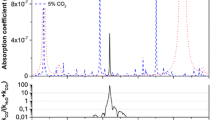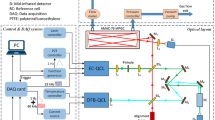Abstract.
Two configurations of a continuous wave quantum cascade distributed feedback laser-based gas sensor for the detection of NO at a parts per billion (ppb) concentration level, typical of biomedical applications, have been investigated. The laser was operated at liquid nitrogen temperature near λ=5.2 μm. In the first configuration, a 100 m optical path length multi-pass cell was employed to enhance the NO absorption. In the second configuration, a technique based on cavity-enhanced spectroscopy (CES) was utilized, with an effective path length of 670 m. Both sensors enabled simultaneous analysis of NO and CO2 concentrations in exhaled air. The minimum detectable NO concentration was found to be 3 ppb with a multi-pass cell and 16 ppb when using CES. The two techniques are compared, and potential future developments are discussed.
Similar content being viewed by others
Author information
Authors and Affiliations
Additional information
Received: 1 November 2000 / Revised version: 19 January 2001 / Published online: 20 April 2001
Rights and permissions
About this article
Cite this article
Menzel, L., Kosterev, A., Curl, R. et al. Spectroscopic detection of biological NO with a quantum cascade laser . Appl Phys B 72, 859–863 (2001). https://doi.org/10.1007/s003400100562
Issue Date:
DOI: https://doi.org/10.1007/s003400100562




